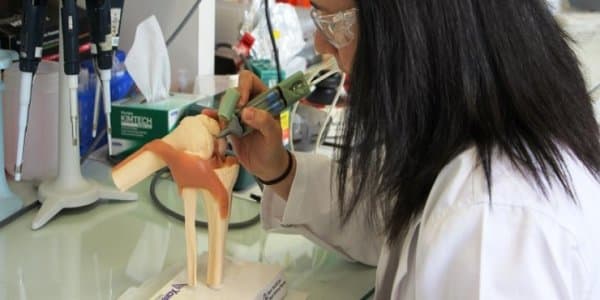'Drawing' Human Stem Cells Using A 3D Printing Pen To Be Possible Soon
A novel collaborative project between the ARC Centre of Excellence for Electromaterials Science (ACES) and St Vincent's Hospital, Melbourne gave birth to a “Printing Pen†tool which can generate stem cells that precisely help in cartilage implants during surgery. Artificially designed cells work more or less similar to a natural stem cell and can improve the support system in times of surgery.
The printing pen is a 3D printing tool which uses hydrogel bio-ink as the filling material and a low powered light source changes the liquid gel into a solid object. Owing to the latest advancement in tissue engineering, scientists used a newly engineered 3D bio-printer which stacked the filling material layer by layer to ultimately create cells.

Although man-made cells synchronize with natural cells and show a survival rate of 97%, it is very difficult to predict the exact geometrical appearance of a tissue before surgeries like cartilage repair. To address the difficulty, the newest invention works efficiently in filling exact organ portions with impairments. Professor Choong explained that a surgeon can easily use the biopen as a regular pen and replace the damaged cells using the output material.
The pen is intensively based on plastic and titanium and is specially designed to help clinicians by serving as a much required surgical tool. If the system is commercialized, according to Professor Wallace, it would redesign the clinical sectors and gift doctors a much desired way of handling rotten tissues. The research work was supported by the Materials Node of the Australian National Fabrication Facility and the complete work was published in the current volume of the Biofabrication journal.
Source: #-Link-Snipped-#
The printing pen is a 3D printing tool which uses hydrogel bio-ink as the filling material and a low powered light source changes the liquid gel into a solid object. Owing to the latest advancement in tissue engineering, scientists used a newly engineered 3D bio-printer which stacked the filling material layer by layer to ultimately create cells.

Although man-made cells synchronize with natural cells and show a survival rate of 97%, it is very difficult to predict the exact geometrical appearance of a tissue before surgeries like cartilage repair. To address the difficulty, the newest invention works efficiently in filling exact organ portions with impairments. Professor Choong explained that a surgeon can easily use the biopen as a regular pen and replace the damaged cells using the output material.
The pen is intensively based on plastic and titanium and is specially designed to help clinicians by serving as a much required surgical tool. If the system is commercialized, according to Professor Wallace, it would redesign the clinical sectors and gift doctors a much desired way of handling rotten tissues. The research work was supported by the Materials Node of the Australian National Fabrication Facility and the complete work was published in the current volume of the Biofabrication journal.
Source: #-Link-Snipped-#
0
